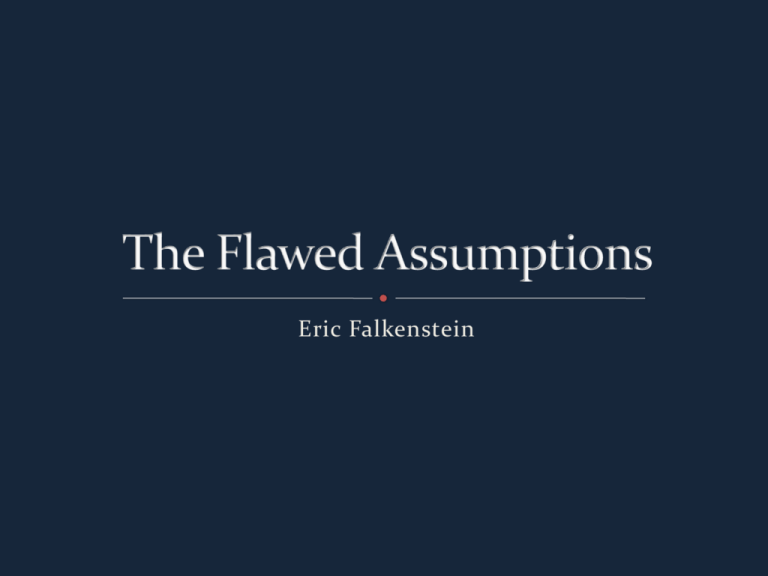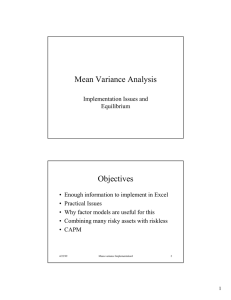PowerPoint File
advertisement

Eric Falkenstein
Assumptions: investor agreement and concave utility
function lead to risk being priced
Implication: Our marginal utility’s covariance with
returns is priced as risky
Implication: Something intuitive should be
identifiable as our marginal utility
As If! Where else does utility, or agreement on
expected returns and volatility, fail?
Securities’ expected
returns
Securities’ standard
deviations
Mean-variance
optimization
Optimal asset
weights
Securities’ correlations
Portfolio choice
3
Select {wi} so as to minimize:
p2 [w1212 ... w 2n n2 ]
[2w1w 21 2 1,2 ... 2w n-1w n n 1 n n 1,n ]
subject to:
(i) E(Rp) > R*
(ii) S wi = 1
Rp
i wi ri
Expected Return
CAPM, APT, etc. trivial
implication
Single Optimal Risky Portfolio
Rf
Standard Deviation
Finding Alpha
5
CAPM article originally rejected because the idea that
everyone agreed on returns and covariances absurd.
Editor changed, paper accepted.
Rubinstein’s aggregation theorem (1974)
Can model market as an individual if they all agree on
probabilities and covariances
Can’t model disagreement
Milgrom-Stokey (1982) no trade theorem
Trade if have private information—make gross profits
Grossman-Stiglitz (1980)
Kyle (1985)
Fundamental Analysis worthless
Markets efficient: mutual funds do not outperform
NYSE turns over 100% per year
Odean and Barber (2000): People turnover 75% of
stocks in individual accounts. Highest quintile 250%
Two-fund separation theorem: Investors hold unique
optimal risky portfolio
Practice: 1000s of mutual funds and ETFs
Less risk
averse
Expected Return
More risk
averse
‘the’ market
everyone holds
Rf
Standard Deviation
Goetzmann and Kumar (2005): >25% have only 1 stock,
>50% less than 3, 5-10% have more than 10.
Average portfolio volatility much greater than market
for average investor
Expected Return
Rf
Standard Deviation
Should invest in world portfolio
Chan, Covrig, and Ng (2005): Everyone is investing
mainly in domestic portfolio
Avoiding easy way to diversify risk
Low covariance with risks from home economy
Fundamental to economic reasoning
Marginal Revolution transformed economics c. 1860s
Walras, Jevons, Menger
Pre 1860s ‘classical’ economists: Marx, Smith, Ricardo,
Mill
Transformed theory of value
X
Slope = Change in Y/Change in X
= MU(Y)/MU(X)
U4
U3
U2
U1
O
X
Y
Income = Px Qx + PyQy
I/Py
Slope = Px/Py
X
O
I/Px
Y
MRS = MUx/MUy= Px/Py
a
b
c
U4
U3
d
U2
e
O
U1
X
Y
a
b
Y1
C’
c
Yo
U5
c”
U4
U3
d
U2
e
U1
O
Xo
X1
X
Utility not applied between goods, but applied to
everything
Von-Neumann-Morgenstern (1944)
EU(x)=prob(x1 )U(x1)+prob(x2 )U(x2 )
Friedman-Savage (1948)
Risk-averse people prefer less variance
Half of all stocks have expected returns below the market
Zero recommendations for firms with expected returns
below the market return
Buy!
Expected Return
Who
cares
?
Risk
Rabin (2000)
Say you reject 50-50 bet to make $11, risking $10
Then you reject any bet where you lose $100
Even:
+$100,000,000,000 if heads
-$100 if tails
Comes from global concavity of utility function
W+11th dollar worth less than 10/11 of W-10th dollar
W+11th+21th (W+32nd) dollar worth less than 10/11 of W+11
dollar. So W+32nd dollar worth 10/11*10/115/6 dollar
Etc.
Within a society, rich people tend to be much happier than poor people.
But, rich societies tend not to be happier than poor societies (or not by much).
As countries get richer, they do not get happier.
Progress and Happiness a Puzzle
Gregg Easterbrook’s The Progress Paradox,
David Myers’s The American Paradox, and
Barry Schwartz’s The Paradox of Choice
Japan: between 1958-1987 per capita income rose 500%
No change in subjective well-being
Knight and Song (2006): Chinese villagers more affected by relative than
absolute wealth, compared to their villages
Choose between
World A: $100,000 a year in perpetuity while others earned $90,000
World B: earn $110,000 while others earned $200,000
Most prefer World A
Libertarians love this:
• with pure greed, individual self-interest
consistent with reciprocal altruism, growth
• With pure envy, not
Torture data to confess
Japan ‘adjustment’
Still not true for USA
People do not approach the problem of investing as a
mean-variance optimization, or factor risk, problem.
Invest based on differing beliefs,
taking lots of idiosyncratic risk when they do,
reaching for absolute return
Necessary and Sufficient Condition for Risk Aversion
Wrong
Absurd extrapolations
Incorrect implications for happiness
And, there appear no general priced risk factors








